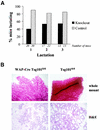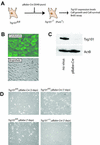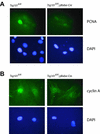Tsg101 is essential for cell growth, proliferation, and cell survival of embryonic and adult tissues
- PMID: 12482969
- PMCID: PMC140677
- DOI: 10.1128/MCB.23.1.150-162.2003
Tsg101 is essential for cell growth, proliferation, and cell survival of embryonic and adult tissues
Abstract
Tumor susceptibility gene 101 (Tsg101) was identified in a random mutagenesis screen for potential tumor suppressors in NIH 3T3 cells. Altered transcripts of this gene have been detected in sporadic breast cancers and many other human malignancies. However, the involvement of this gene in neoplastic transformation and tumorigenesis is still elusive. Using gene targeting, we generated genetically engineered mice with a floxed allele of Tsg101. We investigated essential functions of this gene in vivo and examined whether the loss of function of Tsg101 results in tumorigenesis. Conventional knockout mice were generated through Cre-mediated excision of the first coding exon in the germ line of mouse mammary tumor virus (MMTV)-Cre transgenic mice. The complete ablation of Tsg101 in the developing embryo resulted in death around implantation. In contrast, mammary gland-specific knockout mice developed normally but were unable to nurse their young as a result of impaired mammogenesis during late pregnancy. Neither heterozygous null mutants nor somatic knockout mice developed mammary tumors after a latency of 2 years. The Cre-mediated deletion of Tsg101 in primary cells demonstrated that this gene is essential for the growth, proliferation, and survival of mammary epithelial cells. In summary, our results suggest that Tsg101 is required for normal cell function of embryonic and adult tissues but that this gene is not a tumor suppressor for sporadic forms of breast cancer.
Figures







Similar articles
-
Tsg101 is upregulated in a subset of invasive human breast cancers and its targeted overexpression in transgenic mice reveals weak oncogenic properties for mammary cancer initiation.Oncogene. 2007 Aug 30;26(40):5950-9. doi: 10.1038/sj.onc.1210401. Epub 2007 Mar 19. Oncogene. 2007. PMID: 17369844
-
Targeted deletion of the Tsg101 gene results in cell cycle arrest at G1/S and p53-independent cell death.J Biol Chem. 2002 Nov 8;277(45):43216-23. doi: 10.1074/jbc.M207662200. Epub 2002 Aug 29. J Biol Chem. 2002. PMID: 12205095 Free PMC article.
-
p53 accumulation, defective cell proliferation, and early embryonic lethality in mice lacking tsg101.Proc Natl Acad Sci U S A. 2001 Feb 13;98(4):1859-64. doi: 10.1073/pnas.98.4.1859. Proc Natl Acad Sci U S A. 2001. PMID: 11172041 Free PMC article.
-
The role of Stat3 in apoptosis and mammary gland involution. Conditional deletion of Stat3.Adv Exp Med Biol. 2000;480:129-38. doi: 10.1007/0-306-46832-8_16. Adv Exp Med Biol. 2000. PMID: 10959419 Review.
-
Role of TSG101 in cancer.Front Biosci (Landmark Ed). 2013 Jan 1;18(1):279-88. doi: 10.2741/4099. Front Biosci (Landmark Ed). 2013. PMID: 23276921 Review.
Cited by
-
A mutation in dVps28 reveals a link between a subunit of the endosomal sorting complex required for transport-I complex and the actin cytoskeleton in Drosophila.Mol Biol Cell. 2005 May;16(5):2301-12. doi: 10.1091/mbc.e04-11-1013. Epub 2005 Feb 23. Mol Biol Cell. 2005. PMID: 15728719 Free PMC article.
-
Tumor susceptibility gene 101 ameliorates endotoxin-induced cardiac dysfunction by enhancing Parkin-mediated mitophagy.J Biol Chem. 2019 Nov 29;294(48):18057-18068. doi: 10.1074/jbc.RA119.008925. Epub 2019 Oct 16. J Biol Chem. 2019. PMID: 31619520 Free PMC article.
-
ESCRT proteins: Double-edged regulators of cellular signaling.Bioarchitecture. 2011 Jan;1(1):45-48. doi: 10.4161/bioa.1.1.15173. Bioarchitecture. 2011. PMID: 21866262 Free PMC article.
-
Tumor susceptibility gene 101 is required for the maintenance of uterine epithelial cells during embryo implantation.Reprod Biol Endocrinol. 2021 Jul 16;19(1):112. doi: 10.1186/s12958-021-00788-z. Reprod Biol Endocrinol. 2021. PMID: 34271917 Free PMC article.
-
Schwann cell deletion of Tumor Susceptibility Gene 101 ( Tsg101 ) in mice results in severe peripheral neuropathy.MicroPubl Biol. 2025 Feb 21;2025:10.17912/micropub.biology.001406. doi: 10.17912/micropub.biology.001406. eCollection 2025. MicroPubl Biol. 2025. PMID: 40061016 Free PMC article.
References
-
- Babst, M., G. Odorizzi, E. J. Estepa, and S. D. Emr. 2000. Mammalian tumor susceptibility gene 101 (TSG101) and the yeast homologue, Vps23p, both function in late endosomal trafficking. Traffic 1:248-258. - PubMed
-
- Brugarolas, J., C. Chandrasekaran, J. I. Gordon, D. Beach, T. Jacks, and G. J. Hannon. 1995. Radiation-induced cell cycle arrest compromised by p21 deficiency. Nature 377:552-557. - PubMed
-
- Carney, M. E., G. L. Maxwell, J. M. Lancaster, C. Gumbs, J. Marks, A. Berchuck, and P. A. Futreal. 1998. Aberrant splicing of the TSG101 tumor suppressor gene in human breast and ovarian cancers. J. Soc. Gynecol. Investig. 5:281-285. - PubMed
-
- Deng, C., P. Zhang, J. W. Harper, S. J. Elledge, and P. Leder. 1995. Mice lacking p21CIP1/WAF1 undergo normal development, but are defective in G1 checkpoint control. Cell 82:675-684. - PubMed
Publication types
MeSH terms
Substances
Grants and funding
LinkOut - more resources
Full Text Sources
Other Literature Sources
Molecular Biology Databases
